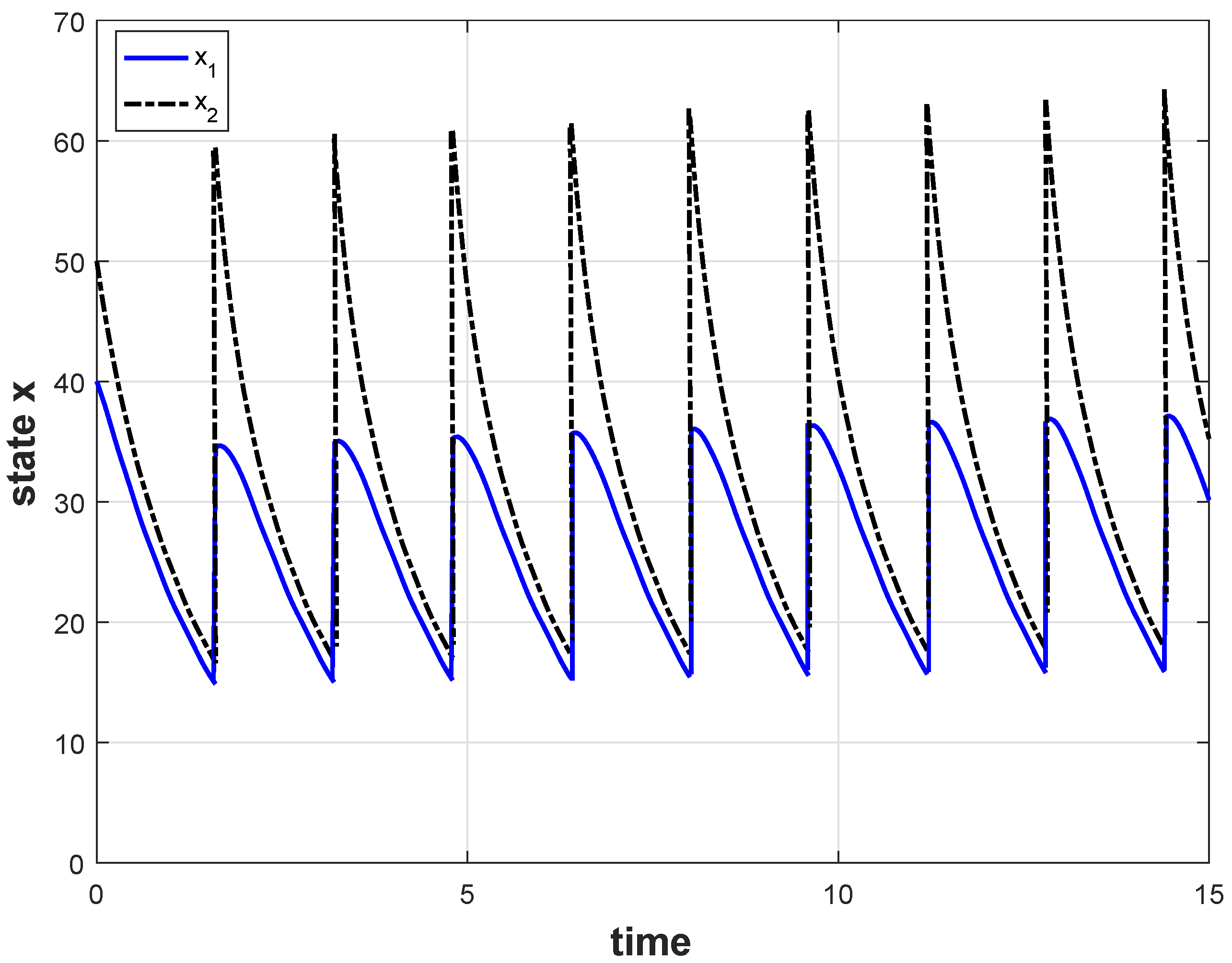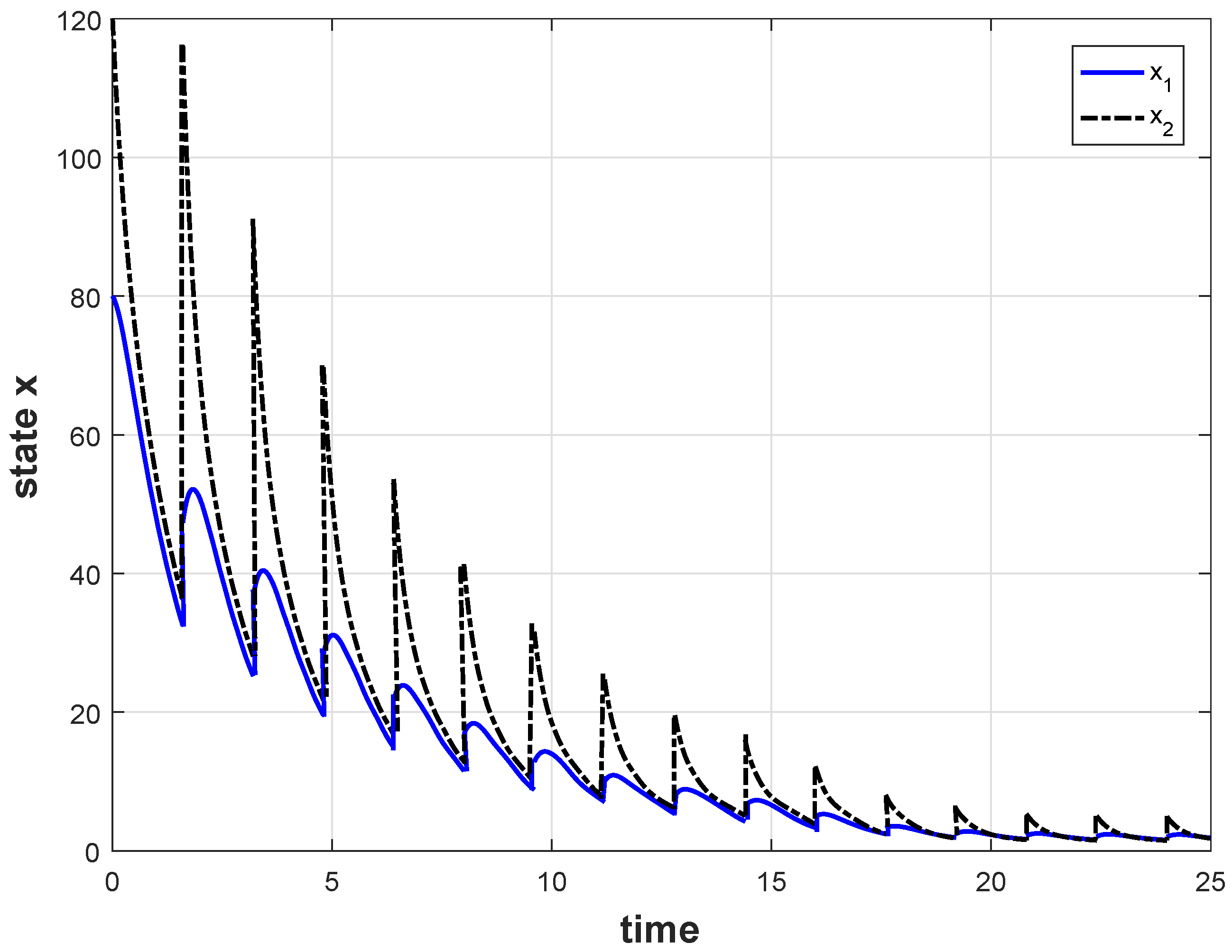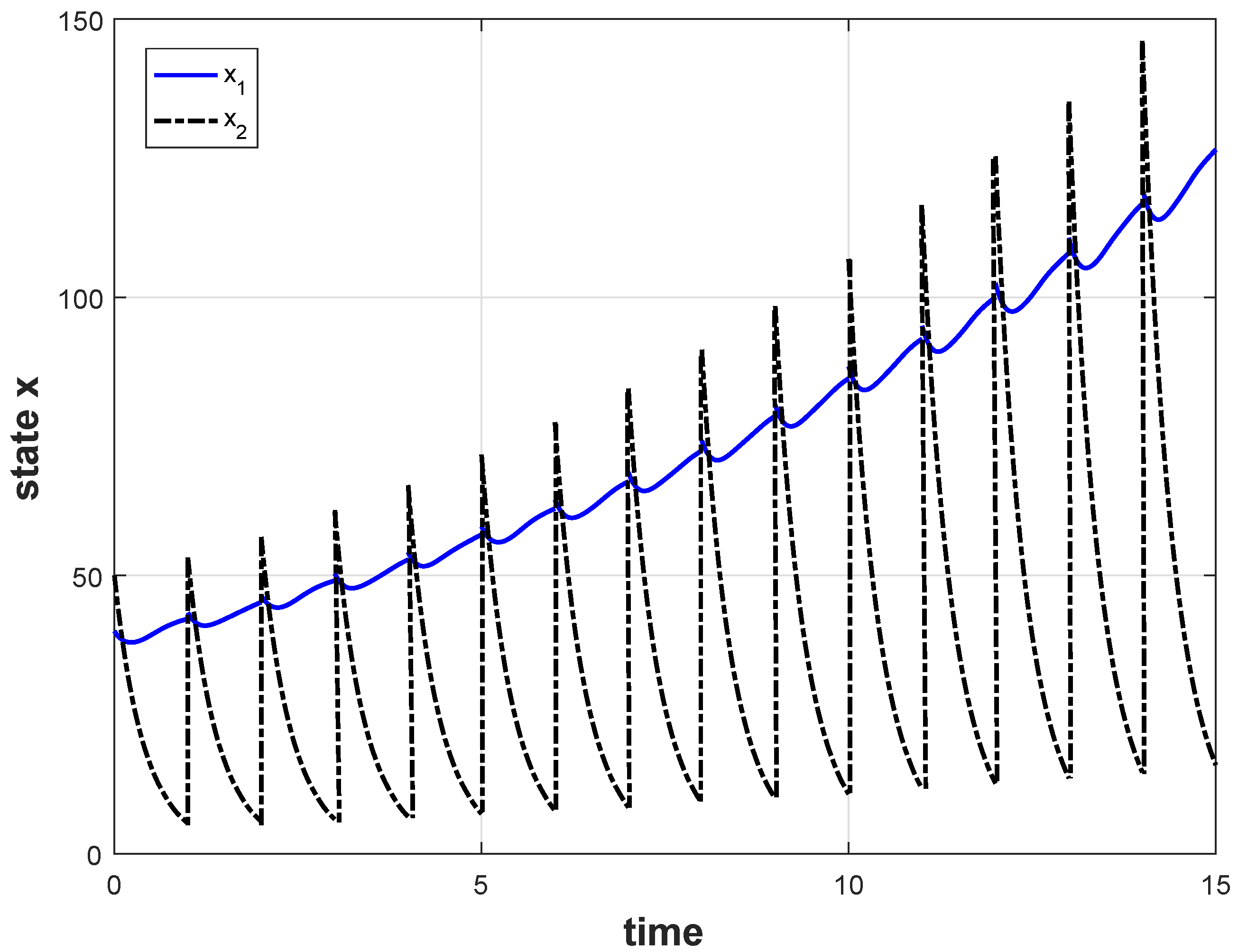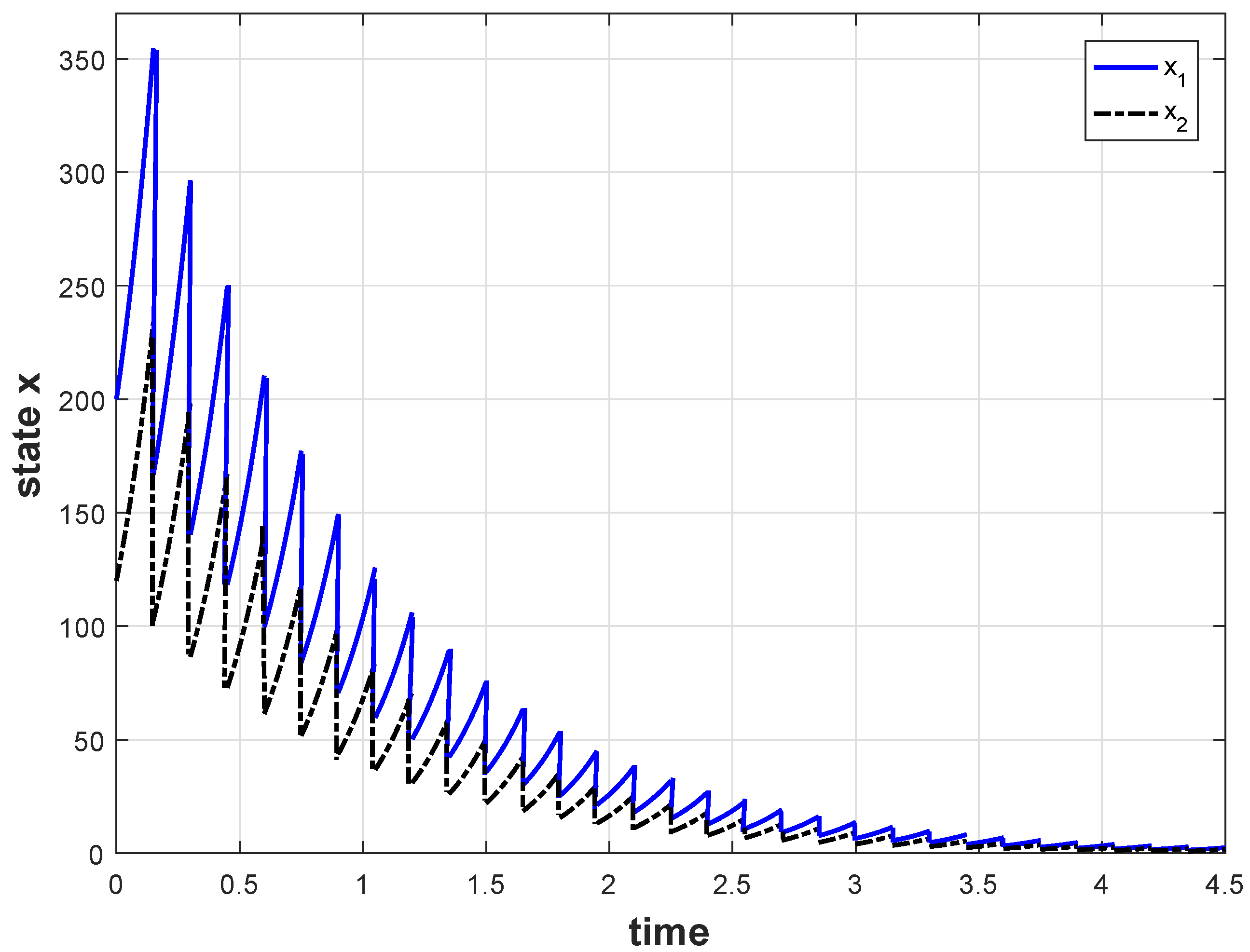1. Introduction
A positive system is a special kind of dynamical system whose state and output variables are non-negative whenever and wherever the initial state and the input variables are non-negative [
1]. In recent years, positive systems have been extensively studied and widely used in many fields, such as biology, chemical industries, economics, and sociology. There are many interesting research results from these fields [
2,
3,
4,
5,
6]. In 1979, the concept of positive systems was first brought forward by Luenberger [
7]. On the basis of the tool of a non-negative matrix, Farina first proposed quadratic diagonal Lyapunov functions and obtained the necessary and sufficient conditions on asymptotic stability for positive systems in 2000 [
1]. As a result, the study of positive systems was rapidly developed. Both stability [
8] and problems of observer design [
9], positive filtering [
10] and saturation control [
11], were studied for positive systems.
The impulse phenomenon is common in engineering applications, which can increase the complexity of system-stability analysis due to the discontinuous system state. In terms of the impact on system stability, impulses are generally divided into three kinds: disturbance, neutral, and stabilizing impulses. Different impulses have different effects on the system, which may hinder convergence or enhance the stability of the considered system. Since the impulsive property and positive constraint lead to abundant dynamic behaviors of an impulsive positive system (IPS), it is necessary and important to investigate the stability and stabilization analysis of IPS. Zhang [
12] first established the sufficient criterion of stability for IPS by using a linear copositive Lyapunov function. Briat [
13] studied the dwell-time stability and stabilization conditions of linear positive impulsive systems.
Input-to-state stability (ISS) theory plays a vital role in the development of modern nonlinear control theory, especially in the robust stability theory of nonlinear systems. The concept of ISS was proposed by Sontag [
14]. Subsequently, its various extensions, such as integral ISS (iISS), finite-time ISS, and stochastic ISS [
15,
16,
17,
18], were developed. Many significant results on ISS were reported for various systems, such as continuous dynamical, discrete, sampled-data nonlinear, time-delay, switched, and networked control systems [
19,
20,
21,
22,
23,
24]. For impulsive systems, the ISS problem was also investigated in [
25,
26,
27], with some sufficient conditions provided on the basis of the Lyapunov function method. In addition, for positive systems, there is little research on ISS [
28], especially for NIPS. ISS is also an effective tool for stabilization design [
29,
30,
31]. However, for the input-to-state stabilization study of NIPS, the coexistence of positivity restrictions and impulses increases the complexity of input-to-state stabilization analysis. In fact, first, because the state variables of positive systems are always limited in the positive quadrant rather than the whole state space, many methods for general system establishment are not applicable or they are applicable but conservative, which brings great challenges to the ISS analysis for NIPS; second, due to the existence of impulses, the non-negative constraints of the system may be destroyed.
In this paper, the ISS problem of NIPS is studied for the first time, with some criteria on ISS and input-to-state stabilization being provided. On the basis of the max-separable ISS Lyapunov function method, a sufficient condition on ISS for general NIPS is provided in which the two following situations of NIPS are included: (1) the continuous dynamic is stable but the impulsive effect is unstable; (2) the impulsive dynamic is stable but the continuous dynamic is unstable. For LIPS and ANIPS, some ISS criteria are also given. From them, corresponding ISS properties can be judged directly from the algebraic and differential characteristics of the systems. On the basis of the ISS criteria for LIPS and ANIPS, state-feedback and impulsive controllers were designed, respectively, which make the systems input-to-state stabilizable. Numerical examples are given to verify the validity of our proposed results.
The remainder of this paper is organized as follows: in
Section 2, the impulsive positive system is formulated, and some notations and definitions are given. In
Section 3, after providing a sufficient condition on ISS for general NIPS by the max-separable ISS Lyapunov function method, some ISS criteria are also given for LIPS and ANIPS. In
Section 4, for input-to-state stabilization problems, both state-feedback and impulsive controllers were designed and are outlined for LIPS and ANIPS, respectively. In
Section 5, three numerical examples are provided to illustrate the proposed results, and the conclusion follows in
Section 6.
2. Preliminaries
Notations: Let , , and denote the sets of all real, non-negative real, and natural numbers, and natural numbers excluding zero, respectively. and denote the n- and -dimensional real spaces, respectively. Positive orthant in is set , where superscript T denotes the transpose. A real matrix is called a Metzler matrix if and only if its off-diagonal entries are non-negative: , . For vectors , we write: if for ; if for ; if and . refers to the vector with all elements of it being 1. The p-norm on is denoted by . When , p is often omitted. The max-norm is denoted as . refers to the interior of which means set . Given a vector , the weighted norm is defined by .
A continuous function is of a class if is strictly increasing and . If is also unbounded, then is of class . A function is of class if for fixed the function is of class , and for fixed the function is decreasing with .
In this paper, we consider the following nonlinear impulsive system with disturbance:
where
is the system state,
is the disturbance input,
denotes the set of all measurable and locally essentially bounded disturbance input
on
with norm as follows:
satisfies
; initial data
;
is a non-negative function with
; disturbance input function
is essentially bounded;
denotes the impulsive jump instant, and discrete time set
satisfies
and
, where
, initial time
and impulsive interval
are finite. When time instant
, state variable
x immediately “jumps” from
to
.
For convenience, we introduce some definitions and proposition for system (
1) as follows.
Definition 1. For any given constants and positive integer , let denote the number of impulsive times of impulse sequence on interval , and let the following hold [32]:then is called the average impulsive interval of σ, and is called the chatter bound. Remark 1. For system (1), two kinds of impulses are mainly considered. When system function f is stable, but impulses could probably destroy stability, we must require that impulses do not happen too frequently, so the number of impulses is limited to . When impulse dynamics are stable with respect to w, but system function f could potentially destroy stability, so we require more impulses to occur and the value of cannot be too large; the number of impulses is limited to . Definition 2. [1] A nonlinear impulsive system (1) is said to be positive if, for any initial condition , we have for any . Definition 3. [33] Function f in system (1) is cooperative if the following is true:where , . Proposition 1. A nonlinear impulsive system (1) is positive if f is cooperative and h is non-negative. Proof. For system (
1) with initial condition
, according to analysis in [
34], because
f is cooperative, one has
for
. When
,
. Since
h is non-negative, one has
. For
, and system (
1) with initial state
, iteratively, one has
for
; generally, for all
,
. So,
for all
, and system (
1) is positive. □
In this paper, the ISS properties of nonlinear impulsive positive systems (NIPS) are considered. For the ISS study of NIPS, the definitions of ISS and max-separable ISS Lyapunov function are first introduced.
Definition 4. [28] NIPS (1) is said to be input-to-state stable (ISS) if there exist scalar functions and such that the following is true: From the properties of
functions [
35] and Remark 1 in [
28], if NIPS (
1) is ISS, it is also ISS in the sense of the
,
and
-norm.
Definition 5. For NIPS (1), a locally Lipschitz positive definite radially unbounded function,with function : is a max-separable ISS Lyapunov function if there are functions , , χ of class and rate coefficients such that, for all , the following is true:andwhere the upper-right Dini derivative is given by the following: denotes the set of indices for which the maximum in (3) is attained, i.e., the following: 3. ISS of Nonlinear Impulsive Positive Systems
In this section, using the max-separable ISS Lyapunov function method, we state and prove the following ISS criterion for NIPS.
Theorem 1. For positive system (1) (uniform ISS), if there is a candidate max-separable ISS Lyapunov function in the form of (3), system (1) is ISS for all impulse sequences . Proof. Define set . The whole proof is performed in two cases: and . Let denote a time at which the trajectory enters set for the first time.
Case 1.. In this case, for any
,
. In view of (
5), we have the following:
From (6),
. Thus we have the following:
From (
2) and (
8), we obtain that, if
,
if
,
In conclusion, the following holds:
where
.
According to the definition of max-separable ISS Lyapunov function and the properties of
functions, the following holds:
Then, we have the following:
So,
where
can be known from Lemma 4.2 in [
35].
Let us now turn our attention to interval
. At
, the system state goes into set
for the first time. If
,
, from Condition (6), the impulsive effect is stabilizing or neutral. After time
, due to the stabilizing or neutral impulses and condition (
5), system states always stay in set
, i.e.,
. So, from (
9), we have the following:
where
can be known from Lemma 4.2 in [
35]. Combining this with (
10), we obtain the following:
Otherwise, if
, the disturbance effect is performed for the impulses. Even if the system state goes into set
, it can also go out due to the disturbance effect of the impulses. Let
. From the above result,
holds when
. From (
9), we obtain the following:
Next, let
. For time
, it is the first time after
such that
. From (
5), the reason for
just comes from the impulsive effect. So, the
is also an impulsive instant. Repeating the argument used to establish (
10), with
in place of
, we obtain the following:
From (
9), we conclude the following:
So,
where
can be known from Lemma 4.2 in [
35].
From (
10), (
11) and (
12), iteratively, we obtain
for
;
for
;
for
. Therefore, the following holds:
where
.
Case 2.. In this case,
. When
, from the proof of
Case 1, we obtain the following:
when
, by the definition of set
and the definition of
, we obtain the following:
In all, system (
1) is ISS for all impulse sequences
. □
Remark 2. For the study of nonlinear positive systems, the influence of impulses is considered for the first time. The max-separable Lyapunov function method is combined with the average dwell-time method for the study of positive systems. Using them, Theorem 1 provides the stability criteria for NIPS.
Remark 3. System (1) is affected by both impulses and perturbation input. From the above proof, upper bound of the solution introduced by the perturbation input may be continuously destroyed due to the action of the impulses. Here, under the general premise of the system positivity requirement, we give a “new upper bound”, which is related to both the impulses and the perturbation input by discussing the time periods of the impulses in sections. Remark 4. The “new upper bound” is introduced because of the influence of impulses. By defining set , can be divided into two parts: and . is the “old upper bound”. Without impulses, this bound can be seen as the ultimate bound of the system states. However, due to the disturbance effect of the impulses (when ), even if the system states enter set , it may break through the “old upper bound”. From our derivation, the “new upper bound” can be used as an “ultimate bound” of the system states of the NIPS.
Remark 5. In Theorem 1, two kinds of impulses are mainly considered:
When , it must necessarily be with , and the value of cannot be too small for Theorem 1 to hold. In this case, (5) implies that system dynamics are ISS with respect to w, but impulses can probably destroy ISS, and we must require that impulses do not happen very often. The number of impulses is limited to the following: When , (6) implies that the impulse dynamics are ISS with respect to w. When , the system dynamics can potentially destroy ISS. So, we must require more impulses to occur and the value of cannot be too large for Theorem 1 to hold. The number of impulses is limited to the following: Now, consider the NIPS (
1) with
and
, where
,
are the constant matrices, and the function
is the disturbance input. Then, NIPS (
1) reduces to a linear impulsive positive system (LIPS) as follows:
For LIPS (
13), the following proposition can be obtained by the max-separable ISS Lyapunov function method.
Proposition 2. For the LIPS (13), suppose that A is a Metzler matrix, and that there exist numbers , and vector such that for any , the following holds: Then, system (13) is ISS for all . Consider an affine nonlinear impulsive positive system (ANIPS) as follows:
where function
is the disturbance input. We first propose some definitions and assumptions for system (
14).
From Definition 3, continuous vector field , which is on , is said to be cooperative if the Jacobian matrix is Metzler for all .
Definition 6. is said to be homogeneous of degree α if for all and all real , [36]. Definition 7. is order-preserving on if for any , [36]. Assumption 1. (i) f is cooperative, continuous, continuously differentiable on and homogeneous of degree 1; (ii) g is continuous on , and bounded by M; (iii) is non-negative, order preserving, and homogeneous of degree 1.
Proposition 3. If Assumption 1 holds, and there exist positive number η and vector satisfyingthen system (14) is ISS for all }. 










